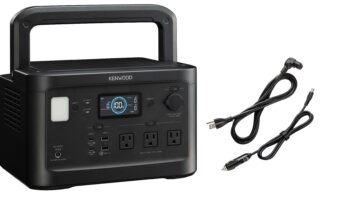NEW YORK — Spurred by the growing environmental movement and the implementation of new EPA EnergyStar 3.0 power-consumption regulations, television manufacturers have rallied to the “green TV” cause this year with new power-efficient TV designs.
In addition, most manufacturers are saying these changes come with little or no impact on the quality of the picture; in fact, some are claiming performance boosts.
One of the problems with the transition to an all-digital TV was the fact that many new TV designs required more power to operate, either due to larger screen sizes than the models they were replacing or through the use of more complex and power-hungry display technologies. As a result, manufacturers have worked diligently to get the power draw down.
“When I started seeing the 5 trillion kilowatt hours of energy being used for TVs back in 2005, that started making the [Department of Energy] very scared and me feel very guilty,” said Bruce Berkoff, president of LCD TV Association, which tests and certifies so-called “Green TVs” under an eco-friendly LCD TV .program.
Berkoff, who worked for LG.Philips and other display companies prior to forming the LCD TV Association, recalled that Philips had started using ambient [room] light sensors in its TVs to automatically reduce picture brightness to match the surrounding light levels.
“One of the first things the LCD TV Association’s Green TV program did was to show manufacturers that if you used an inexpensive ambient light sensor in a TV, you could save at least 30 percent on energy when you turn the lights out in the room,” Berkoff said.
The LCD TV Association established its “Green TV” program to recognize those products and to give manufacturers one more label they could use to show consumers that the sets are truly power efficient.
LG Electronics was the first to submit products to the association for testing, he said, “and they showed over 60 percent energy savings, and others including Vizio are moving in that direction.”
The association has now expanded the program to reduce energy consumption further and to go beyond energy efficiency to include product-recycling programs, and to use less packaging through new packaging designs and materials.
In addition to the Green TV program the Environmental Protection Agency’s EnergyStar program has established its EnergyStar 3.0 guidelines to show consumers that a TV is staying within more stringent power consumption parameters.
The standard is applied to two states of operation: when a TV is in the “off” or “standby” position and when it is fully operational. In short, when a TV is in standby (off but remote operable) mode it is to consume no more than 1 watt of power, and when the set is in standard home viewing mode, power consumption levels must not exceed the following formulas:
• HDTVs that have less than 680 square inches viewing area must consume equal or less power of 0.2 times the screen area in square inches plus 32.
• HDTVs with 680 to 1045 square inches of viewing area must consume no more watts of power than 0.240 times the screen area plus 27.
• HDTVs with a viewing area of more than 1,045 square inches must consume equal or less watts of power than 0.156 times the screen area plus 151.
Manufacturers are addressing these new requirements, and more, with a variety of techniques.
Panasonic, for example, revealed at International CES in January that is was employing new NeoPDP technology in all 2009 1080p plasma TV models. The system uses 50 percent of the power required for comparably sized models from a year ago at the same picture brightness. To accomplish the feat Panasonic introduced a dramatically more efficient phosphor material designed to emit more light, said Bob Perry, Panasonic executive VP.
The company also improved the efficiency of the drive circuits that apply power to each area of the panel that creates the plasma gas, he said.
“The wasted electricity on a drive circuit in a television would be expressed in the form of heat. We actually make the plasmas with a more efficient electrical drive circuit, which also means it runs cooler,” Perry said.
Sony has delivered a new series of LCD TVs that are focused on keeping power to a minimum. The Bravia VE5 series, or Eco Tvs, due to ship this summer, omit conventional cold cathode fluorescent backlighting in favor of hot cathode fluorescent lamps (HCFL), which are similar to conventional office-lighting systems.
Nate Kraft, Sony Bravia senior TV marketing manager, said, “You aren’t sacrificing the form factor of an LCD with a huge thick box. You aren’t turning your LCD into a CRT again. It allows us to have a very bright backlight in a very small amount of space.”
In addition, the Eco TV sets include a hard-power switch that completely turns off the display without the slow draw of a standby mode. Kraft said eco-minded consumers will change their habits and dispense with the remote control to turn on the TV. Others have the option of shutting off the TV and entering a standby mode.
The hard power-off feature is convenient for people who don’t watch a lot of TV or plan to leave the house for an extended period of time, Kraft explained.
Eco TVs also have a Presence Sensor, which senses motion in the room. If no one is detected by the TV for a preset period of five, 30 or 60 minutes, the backlight is switched off. If no motion is detected 30 minutes after that, the set switches to standby mode.
“With a tremendous energy savings, these sets give you the same performance level of LCD TVs of similar size,” Kraft said.
An increasingly popular method of reducing the power draw in LCD TVs is to replace the CCFL back-lighting system with an array of LEDs.
This approach is more expensive than using CCFLs, but it generates more light per applied watt of power. Another trick some manufacturers use is to switch the backlighting on and off very rapidly. This controls the amount of light applied very dynamically so that the over all average power usage is lowered.
Samsung, which has had LED LCD TVs for several years, was among the pioneers of LED TV technology.
In addition to making a global contribution toward improving the environment, Samsung LCD TV marketing VP Jonas Tanenbaum said Samsung has been making strides to reduce the power consumption of its television sets because “there is a strong voice from consumers that it is an increasingly important part of their purchase decision.”
Although it has offered LCD TVs with LED backlighting for the past three years, Samsung elected to spread the capability to between 30 percent and 40 percent of the its LCD TV business in 2009.
LED-based backlighting, Tanenbaum said, reduces power-consumption levels, removes toxic mercury vapor from the waste stream, and allows for thinner, lighter products that require less packaging materials and less energy to transport.
Perhaps more importantly to some, he said, the technology helps to improve the color and contrast performance of LCD TVs over those driven by more conventional CCFL back-light systems.
Samsung is offering LED backlighting in three model series, with a variety of configuration approaches.
Models that use so-called “edge-lit” LED configurations will allow for thinner cabinet depths, but it’s uncertain if these will draw different power levels than slightly thicker models due later in the year that will add local-dimming technology to further improve color and contrast performance, Tanenbaum said.
The edge-lit LED LCD TVs will require up to 40 percent less electricity to operate than a traditional CCFL back-lit LCD TV of similar size, Tanenbaum said. So a Samsung 46-inch LED LCD TV will use approximately 100 watts of electricity while a 46-inch CCFL LCD TV can use more than 200 watts of power, he said.












